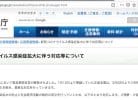Revision Overview
June 1, 2008 – The Japanese Patent Office (JPO) published a notice proposing a number of changes in the Japanese patent and trademark law. The goal is to accelerate and optimize the strategic exploitation of Intellectual Property Rights (IPR) with a particular emphasis on relieving the fee burden for small entity status applicants (independent inventors, small business concerns or non-profit organizations). There are four proposed new rules, the first of which will go into effect immediately. The rest are projected to start January 1, 2009.
The proposed revisions are as follows: (1) a reduction in patent and trademark-related fees; (2) revisions in the period for filing a demand for a trial against an examiner’s final decision of rejection; (3) the updating of JPO’s electronic system to increase the number of intellectual property offices participating in the electronic transfer of priority documents; (4) revisions in the registration system for non-exclusive licensing of utility models.
Discussion of Specific Rules
I. Adjustments in Patent and Trademark Fees (effective June 1, 2008)
JPO will implement an adjustment in patent and trademark-related fees effective June 1, 2008. JPO’s patent and trademark rates have long been known to be higher than other foreign countries, and this has been a source of complaint particularly among small and mid-sized companies who have taken the brunt of the cost burden. The new law will reflect discounts in both patents and trademark fees with official patent fees going down an average of 12% and official trademark fees going down an average of 43%. The deepest discounts in official fees for patents will be for those patents 10 years and older. The average official fee for a 10 year old patent will go from $4900 to $4300. An average 20 year old patent will go from $16,800 to $13,400 (note: fees will vary depending upon the number of claims in the specifications). Official trademark fees will also come down with biggest reductions in fees for trademarks 10 years or older. The average 10 year old trademark’s renewal fee will go from $1,510 to $485 (note: fees will vary depending upon the number of classifications). Below is a table of the crucial fee changes:
1. Application Fees Old fees New fees
*International Patent applications (approx.) $160 (approx.) $150
entering into the national
phase in Japan (under the PCT)
*Trademark (approx.) $210 (approx.) $230 per classification per classification
2. Annual Fees/Registration Fees Old fees New fees
*Patents (For patent applications
requested for examination on or after April 1, 2004 (approx.) (approx.)
10-25th year: annually $812+$64 $612+$48 per claim per claim
*Trademark Registration Fee (approx.) $660 (approx.) $380 per classification per classification
*Renewal Fee (approx.) $1510 (approx.) $485 per classification per classification
For more details on the new schedule of fees, click here for a link to the JPO web site.
II. Revisions in Non-Exclusive Utility Models Licensing Registration (effective April 1, 2009)
Background and New Rules:
(1) The pending period from filing a patent application to receiving a patent can take several years. However, licensing the right to patent before a patent is granted is on the rise. This is particularly true among University TLOs and venture companies who are need of a cash flow to supply continued research. They need to market inventions immediately. In Japan, license agreements for pending patents do not provide protection against license transfer in the event a party goes bankrupt. The new ownership could potentially have the terms of the license changed, or even terminated.
The proposed new law will put in place a registration system which would allow license agreements for patent pending applications to be filed with the JPO. This system will provide protection for the licensee against the new owner’s injunction, demand for compensation, and contract annulment, etc., if the other party goes bankrupt and transfers the license to a new owner.
(2) With an ever greater demand for licensee protection, JPO promulgated a revision in the current non-exclusive license registration’s license disclosure requirement. The new rule makes accessible certain sensitive information only to the parties involved and not the general public. Starting January 1, 2009. the following information will be privileged information: licensee name, the license’s scope of claim, and the name of the bankruptcy administrator.
(*Note: Exclusive licenses confer rights to the exclusion of all others with a serious impact on other parties. Therefore, its disclosure requirements will remain the same.)
III. Extending The Period for Filing a Demand for a Trial Against An Examiner’s Final Decision of Rejection (effective April 1, 2009)
Background and New Rules:
JPO has responded to a long-standing complaint that the period for filing a demand for a trail was too short. In light of the allotted time given by other intellectual property offices, this certainly seems to be the case: 3 months in the U.S., 2 months in the E.U. and 3 months in China. The new time table is as follows:
(1) For Japanese applications, the period for filing a demand for a trial against an examiner’s final decision will be extended from 30 days to 3 months.
(2) For foreign applications, the period for filing a demand for a trial against an examiner’s final decision will be extended from 3 months to 4 months. Prior to the revision, the applicant was given 60 days to appeal after receiving the final refusal and an additional 30 days to file an amendment. The new law requires that the appeal and the amendment be filed at the same time.
(3) For designs and trademarks, the period for filing a demand for a trial against an examiner’s final decision of rejection and for the amendment will also be extended from 30 days to 3 months.
IV. Increasing the number of foreign Intellectual Property Offices to Participate in Electronically Transferred Priority Documents (effective January 1, 2009)
JPO has promulgated the expansion of the number of foreign intellectual property offices permitted to transfer electronically certified copies of priority documents. In order to support a smooth application process and a smooth administrative procedure, not only will priority documents from the original countries be accepted, but electronic transfer of priority documents from other international offices will also be accepted.
(Posted June 2, 2008)






